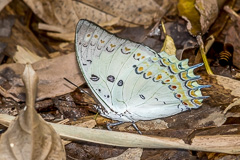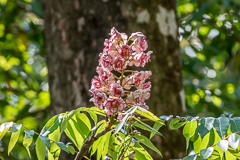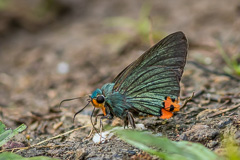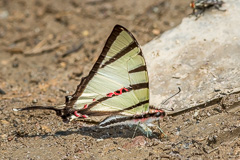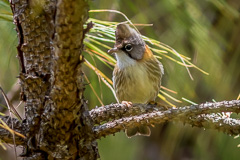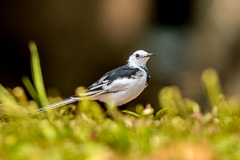Overview
Dates: |
26 Feb - 2 Mar 2018 |
With Steve Tibbett. Following on from a far from successful trip in November 2017, this repeat visit to Doi Phu Kha - always an interesting corner of Thailand, but time consuming to reach - targeted both birds and, hopefully, some rarer butterflies. 26 Feb. Left Chiang Mai 06:00, arriving at Tat Man by 12:00. As significantly drier than our previous visit, very few butterflies in evidence along the verges of the entrance road. However, much improved around the waterfall and streams, including at least 20 Great Nawab, Shan Nawab and a Jewelled Nawab. We remained in the area until activity eased around 16:00, then drove to Pua, where we'd opted to stay at a different hotel than previously in order to avoid the all-nighter chickens. 27 Feb. Heavy overnight rain. Where the hell did that come from? So consequently a cool, cloudy start to the day. During the morning we birded and looked for butterflies in several spots between the park entrance and the pass at 1,700 metres, that was initially fogged in. We noted at the shrine area that the Chompoo Phu Kha trees Bretschneidera sinensis for which the park is named, are flowering well at this time of year. Little butterfly activity until at least 12:00, but a fair collection of birds including Mountain Hawk-Eagle, Long-tailed Broadbill, Indochinese Yuhina and Silver-eared Mesia. Late afternoon we took a walk inside the mixed pine and deciduous forest near the park entrance, though little seen. An interesting area, with seemingly good habitat, that requires a subsequent visit. 28 Feb. A great start with Formosa Awlking as the first butterfly of the day. We then tried another walk along the fire break at the pass, but again cool and mostly dead, so back to points lower down the mountain where, despite better weather, nowhere near as productive as yesterday. Mid afternoon we took yet another, much longer walk on the fire break. The most interesting ornithological observation was a calling Grey Peacock-Pheasant, a species now rarely reported from northern Thailand. Although numbers of butterflies poor we did manage to find Blue Caliph, Mountain Columbine, Tailed Labyrinth, Dull Forester and Common Forester - the later much scarcer than its name suggests. As we'd been able to book only two nights at our first hotel we needed to change, and although having a booking and coordinates we spent an hour trying to locate the place. Evidently not that well known by the locals, and incorrect coordinates didn't help! Eventually, having located it we discovered no staff in attendance, just a phone number on the desk and two keys that we took to be ours, so moved in. 1 Mar. Still no staff present at the hotel, so back to the field, where today we'd decided to try the high ridge above the park Nature Trail for Beautiful Nuthatch. It took just over two hours from the headquarters to reach the saddle on the ridge. From here, another climb took us to almost 2,000 metres, where we spent several hours. Unfortunately no Beautiful Nuthatch, but a good selection of other species, such as Bianchi's Warbler, Rufous-backed Sibia, Whiskered Yuhina and Black-eared Shrike-babbler. Butterflies exceptionally poor. Back at the hotel still no staff present, so phoned the owner and pleaded to pay! 2 Mar. Due to the reasonable long drive to Chiang Mai we decided to leave relatively early and try a couple of spots en route. First up was Namtok Nam Min Forest Park, a site we knew nothing of, but had found with an Internet search. At just over a two hour drive from Pua, this park consisted of a small, but scenic, waterfall within a small forested area. Two hours here, gave us a few interesting butterflies, such as Bhutea Lineblue, Swinhoe's Ace and White-banded Pierrot. Continued our drive to Chiang Mai, making further stops in Doi Luang National Park at Tan Tong and Wang Kaeo waterfalls, with the later being particularly promising, as despite late in the day, enough seen to warrant a subsequent trip. |
Species List
| Doi Phu Kha | Count | ||||
| Grey Peacock-Pheasant | 1 | ||||
| Mountain Hawk-Eagle | 1 | ||||
| Common Emerald Dove | 1 | ||||
| Banded Bay Cuckoo | 4 | ||||
| Square-tailed Drongo-Cuckoo | 1 | ||||
| Collared Owlet | 2 | ||||
| Asian Barred Owlet | 3 | ||||
| Himalayan Swiftlet | 2 | ||||
| Great Barbet | 4 | ||||
| Golden-throated Barbet | 4 | ||||
| Blue-throated Barbet | 5 | ||||
| White-browed Piculet | 1 | ||||
| Long-tailed Broadbill | 4 | ||||
| Bar-winged Flycatcher-shrike | 10 | ||||
| Ashy Woodswallow | 2 | ||||
| Black-winged Cuckooshrike | 3 | ||||
| Grey-chinned Minivet | 2 | ||||
| Scarlet Minivet | 4 | ||||
| Grey-backed Shrike | 2 | ||||
| White-bellied Erpornis | 2 | ||||
| White-browed Shrike-babbler | 6 | ||||
| Black-eared Shrike-babbler | 3 | ||||
| Hair-crested Drongo | 1 | ||||
| Yellow-cheeked Tit | 4 | ||||
| Black-crested Bulbul | 2 | ||||
| Flavescent Bulbul | 20 | ||||
| Grey-eyed Bulbul | 8 | ||||
| Mountain Bulbul | 8 | ||||
| Black Bulbul | 6 | ||||
| Asian House Martin | 40 | ||||
| Eastern Red-rumped Swallow | 5 | ||||
| Mountain Tailorbird | 10 | ||||
| Slaty-bellied Tesia | 6 | ||||
| Pallas's Leaf Warbler | 1 | ||||
| Yellow-browed Warbler | 2 | ||||
| Davison's Leaf Warbler | 20 | ||||
| Grey-crowned Warbler | 1 | ||||
| Bianchi's Warbler | 1 | ||||
| Martens's Warbler | 1 | ||||
| Hill Prinia | 4 | ||||
| Grey-throated Babbler | 3 | ||||
| Golden Babbler | 4 | ||||
| Yunnan Fulvetta | 10 | ||||
| Silver-eared Laughingthrush | 6 | ||||
| Blue-winged Minla | 2 | ||||
| Silver-eared Mesia | 2 | ||||
| Rufous-backed Sibia | 6 | ||||
| Dark-backed Sibia | 2 | ||||
| Indochinese Yuhina | 20 | ||||
| Whiskered Yuhina | 2 | ||||
| Chestnut-bellied Nuthatch | 1 | ||||
| White-rumped Shama | 2 | ||||
| Hill Blue Flycatcher | 2 | ||||
| Large Niltava | 2 | ||||
| Small Niltava | 2 | ||||
| Slaty-backed Flycatcher | 3 | ||||
| Taiga Flycatcher | 1 | ||||
| Blue Rock Thrush | 1 | ||||
| Fire-breasted Flowerpecker | 2 | ||||
| Black-throated Sunbird | 3 | ||||
| Little Spiderhunter | 1 | ||||
| Streaked Spiderhunter | 2 | ||||
| Grey Wagtail | 2 | ||||
| White Wagtail | 1 | ||||
| Olive-backed Pipit | 4 |

